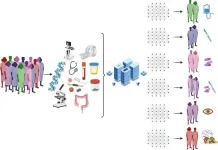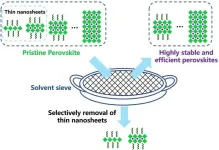(Press-News.org) Researchers have found that adolescents being bullied by their peers are at greater risk of the early stages of psychotic episodes and in turn experience lower levels of a key neurotransmitter in a part of the brain involved in regulating emotions. The finding suggests that this neurotransmitter — a chemical messenger that transmits nerve impulses for communication by a nerve cell — may be a potential target for pharmaceutical interventions aimed at reducing the risk of psychotic disorders.
Psychosis is a mental state characterized by loss of contact with reality, incoherent speech and behavior, and typically hallucinations and delusions seen in psychiatric disorders such as schizophrenia.
Recent studies investigating links between neurological and psychiatric features of certain disorders have found that individuals who experience their first episode of psychosis or have schizophrenia that remains treatable, have lower-than-normal levels of glutamate, a neurotransmitter in the brain’s anterior cingulate cortex (ACC) region. The ACC is known to play a crucial role in regulating emotions, decision-making and cognitive control, while glutamate is the most abundant neurotransmitter in the brain and is involved in a wide range of functions, including learning, memory and mood regulation.
Alterations in glutamate levels have been implicated in various psychiatric disorders, including schizophrenia, depression and anxiety, and so measuring ACC glutamate levels can provide valuable insights into the mechanisms of the nervous system underlying these disorders and their treatment.
However, until now, changes in glutamate levels in the ACC in those individuals at high risk of psychosis, and the relationship between this and the effects of bullying in adolescents has remained unclear.
And so researchers at the University of Tokyo used magnetic resonance spectroscopy, or MRS, a type of radiological imaging applied to depict brain structure and function, to measure glutamate levels in the ACC region of Japanese adolescents. They then measured the glutamate levels at a later point, allowing them to assess changes over time, and compare these changes to experiences with bullying or lack thereof, as well as with any intention on the part of those experiencing bullying to seek help.
Bullying victimization was tracked via questionnaires completed by the adolescents. The researchers then used formalized psychiatric measurement to assess experiences of bullying victimization based on those questionnaires, such as tallying the frequency and assessing the nature of events involving physical or verbal aggression, and also capturing their impact on overall mental health.
They found that bullying was associated with higher levels of subclinical psychotic experiences in early adolescence — those symptoms come close to psychosis but do not meet the full criteria for a clinical diagnosis of a psychotic disorder, such as schizophrenia. These symptoms or experiences can include hallucinations, paranoia or radical alterations in thinking or behavior and can have a significant impact on well-being and functioning, even in the absence of a psychotic disorder diagnosis.
“Studying these subclinical psychotic experiences is important for us to understand the early stages of psychotic disorders and for identifying individuals who may be at increased risk for developing a clinical psychotic illness later on,” said Naohiro Okada, lead author of the study and project associate professor at the University of Tokyo’s International Research Center for Neurointelligence (a research center under Japan’s World Premier International Research Center Initiative program).
Crucially, the researchers found that higher levels of these subclinical psychotic experiences were associated with lower levels of anterior cingulate glutamate in early adolescence.
“First and foremost, anti-bullying programs in schools that focus on promoting positive social interactions and reducing aggressive behaviors are essential for their own sake and to reduce the risk of psychosis and its subclinical precursors,” said Okada. “These programs can help create a safe and supportive environment for all students, reducing the likelihood of bullying and its negative consequences.”
Another potential intervention is to provide support and resources for adolescents who have experienced bullying victimization. This might include counseling services, peer support groups and other mental health resources that can help adolescents cope with the negative effects of bullying and develop resilience.
While Okada’s group has identified a potential target of pharmacological interventions, he added that nonpharmacological interventions such as cognitive behavioral therapy or mindfulness-based interventions may also serve to target this neurotransmitter imbalance.
###
Funding:
This work is a part of the Tokyo TEEN Cohort Study and was supported by MEXT/JSPS KAKENHI, JST Moonshot R&D, AMED and NIH. This work was also partially supported by WPI-IRCN, UTIAS, and Open Access funding provided by The University of Tokyo.
Related links:
International Research Center for Neurointelligence: https://ircn.jp/en/
About the World Premier International Research Center Initiative (WPI)
The WPI program was launched in 2007 by Japan's Ministry of Education, Culture, Sports, Science and Technology (MEXT) to foster globally visible research centers boasting the highest standards and outstanding research environments. Operating at institutions throughout Japan, the 18 centers that have been adopted are given a high degree of autonomy, allowing them to engage in innovative modes of management and research. The program is administered by the Japan Society for the Promotion of Science (JSPS).
See the latest research news from the centers at the WPI News Portal: https://www.eurekalert.org/newsportal/WPI
Main WPI program site: https://www.jsps.go.jp/english/e-toplevel
About the International Research Center for Neurointelligence (IRCN), The University of Tokyo
The IRCN was established at the University of Tokyo in 2017, as a research center under the WPI program to tackle the ultimate question, “How does human intelligence arise?” The IRCN aims to (1) elucidate fundamental principles of neural circuit maturation, (2) understand the emergence of psychiatric disorders underlying impaired human intelligence, and (3) drive the development of next-generation artificial intelligence based on these principles and function of multimodal neuronal connections in the brain.
Find out more at: https://ircn.jp/en/
About the University of Tokyo
The University of Tokyo is Japan's leading university and one of the world's top research universities. The vast research output of some 6,000 researchers is published in the world's top journals across the arts and sciences. Our vibrant student body of around 15,000 undergraduate and 15,000 graduate students includes over 4,000 international students. Find out more at https://www.u-tokyo.ac.jp/en/ or follow us on X (formerly Twitter) at @UTokyo_News_en
END
Bullied teens’ brains show chemical change associated with psychosis
2024-02-05
ELSE PRESS RELEASES FROM THIS DATE:
Unlocking precision medicine for inflammatory bowel disease
2024-02-05
The prevalence of inflammatory bowel disease (IBD), encompassing ulcerative colitis (UC) and Crohn's disease (CD), is rapidly increasing worldwide, affecting an estimated 6.8 million people. This surge brings significant economic burdens, with annual healthcare costs exceeding $12,000 and $7,000 for CD and UC patients, respectively. Tailored drug selection based on individual factors can potentially reduce these costs and improve patient outcomes.
Factors associated with a Western lifestyle such as urbanization, high animal protein intake, ultra-processed foods, and reduced fiber ...
High production of polyols using crude glycerol by wild-type safe yeasts
2024-02-05
Utilizing crude glycerol for the synthesis of high-value products offers a promising solution to counter the adverse effects of declining glycerol prices in the biodiesel sector. The prevalence of crude glycerol, a by-product of biodiesel production, across agriculture, biofuel, and industrial sectors is steadily rising. Recent advancements have demonstrated the effectiveness of both wild-type and mutant yeast strains as microbial cell factories capable of converting glycerol into a diverse array of valuable compounds, including microbial oils, sugar-alcohols (polyols), and organic acids. With the projected increase in biodiesel production, there is a need to explore integrated ...
Solvent sieve method sets new record for perovskite light-emitting diodes
2024-02-05
Using a simple solvent sieve method, researchers from the Ningbo Institute of Materials Technology and Engineering (NIMTE) of the Chinese Academy of Sciences (CAS) have taken the lead in developing highly efficient and stable perovskite light-emitting diodes (PeLEDs) with record performance.
The study was published in Nature Photonics.
Perovskites are one of the most promising optoelectronic materials due to their excellent optoelectronic performance and low preparation cost. Compared with traditional organic light-emitting diodes (OLEDs), PeLEDs have a narrower light-emitting spectrum and superior color ...
Combination therapy lowers blood pressure in patients receiving ibrutinib
2024-02-05
(WASHINGTON, Feb. 5, 2024) – Combination treatments with two or more blood pressure drugs can significantly reduce blood pressure in patients taking ibrutinib, according to a new study published in Blood Advances.
Targeted drugs such as ibrutinib have improved outcomes for patients with cancers of the lymphatic system, but patients treated with ibrutinib and other drugs in its class often develop new or worsening high blood pressure (or hypertension or HTN). Few studies have examined how best to treat this potentially serious side effect, nor do any formal guidelines exist to steer doctors toward the most effective treatments.
“To ...
Ultra-sensitive lead detector could significantly improve water quality monitoring
2024-02-05
Engineers at the University of California San Diego have developed an ultra-sensitive sensor made with graphene that can detect extraordinarily low concentrations of lead ions in water. The device achieves a record limit of detection of lead down to the femtomolar range, which is one million times more sensitive than previous sensing technologies.
“With the extremely high sensitivity of our device, we ultimately hope to detect even the presence of one lead ion in a reasonable volume of water,” said Prabhakar Bandaru, a professor in the Department of Mechanical and Aerospace Engineering at the UC San Diego Jacobs School of Engineering. “Lead exposure is a serious health concern, ...
World’s largest childhood trauma study uncovers brain rewiring
2024-02-05
The world’s largest brain study of childhood trauma has revealed how it affects development and rewires vital pathways.
The University of Essex study – led by the Department of Psychology’s Dr Megan Klabunde – uncovered a disruption in neural networks involved in self-focus and problem-solving.
This means under-18s who experienced abuse will likely struggle with emotions, empathy and understanding their bodies.
Difficulties in school caused by memory, hard mental tasks and decision making may also emerge.
Dr ...
Number of shark bites consistent with recent trends, with small spike in fatalities
2024-02-05
There was an increase in the number of unprovoked shark attacks worldwide and an uptick in fatalities in 2023 compared to the previous year. The University of Florida’s International Shark Attack File (ISAF), a scientific database of global shark attacks, confirmed 69 unprovoked bites in 2023. Although this is higher than the most recent five-year average of 63 attacks, the data remain consistent with long-term trends.
Ten of the past year’s unprovoked attacks were fatal, up from five the year before, with a disproportionate number occurring in Australia. Although the country accounted for 22% of all attacks, ...
Schmidt Sciences awards $1.95M gift to Mount Sinai's Windreich Department of Artificial Intelligence and Human Health to establish The Eric and Wendy Schmidt AI in Human Health Fellowship Program
2024-02-05
New York, NY (February 5, 2024) — The Windreich Department of Artificial Intelligence (AI) and Human Health at the Icahn School of Medicine at Mount Sinai announced a transformative $1.95 million gift from Schmidt Sciences to create The Eric and Wendy Schmidt AI in Human Health Fellowship Program. The gift will support an inaugural cohort of five fellows over a three-year fellowship.
By leveraging AI and machine learning to tackle the increasing volume of data in health care, The Eric and Wendy Schmidt AI in Human Health Fellows will play a pivotal role in advancing medical research. ...
NFL PLAY 60 Fitness Break broadcast delivers movement minutes in advance of Super Bowl LVIII
2024-02-05
DALLAS, Feb. 5, 2024 — The American Heart Association and the National Football League (NFL), in collaboration with its 32 NFL clubs, are challenging kids to get moving and PLAY 60 in advance of Super Bowl LVIII with the latest installment of the NFL PLAY 60 Fitness Break broadcast series. On Thursday, February 8 at 1 p.m. ET/ 12 p.m. CT/ 10 a.m. PT the Association and the NFL will deliver an action packed, 15-minute synchronous broadcast to help students add movement to their day leading up to the big game along with ...
Microbial division of labor produces higher biofuel yields
2024-02-05
CHAMPAIGN, Ill. — Scientists have found a way to boost ethanol production via yeast fermentation, a standard method for converting plant sugars into biofuels. Their approach, detailed in the journal Nature Communications, relies on careful timing and a tight division of labor among synthetic yeast strains to yield more ethanol per unit of plant sugars than previous approaches have achieved.
“We constructed an artificial microbial community consisting of two engineered yeast strains: a glucose specialist and a xylose specialist,” said Yong-Su Jin, a professor of food science and human nutrition ...







